This post may contain affiliate links, which means I’ll receive a commission if you purchase through my links, at no extra cost to you. Please read full disclosure for more information.
A decision to take the CFA Level 1 Exam is a decision to commit to rigorous study. You’ll end up spending months and hundreds of hours going through the 60 readings of the textbook material. With the vastness of the material the exam covers, a proper CFA study plan is essential.
In this post, I’ll give a comprehensive breakdown of how to study for the CFA Level 1 Exam.
Brief: My CFA Level 1 Results
Before we dive in, it may help to share my Level 1 results.
I took Level 1 in August 2021, which ended up having a 26% passing rate (3rd lowest ever).
It was my first time sitting for the exam and thankfully I passed on the first attempt. On top of that, I scored well above the 90th percentile. Passing in general had me jumping for joy, but clearing the 90th percentile was icing on the cake.
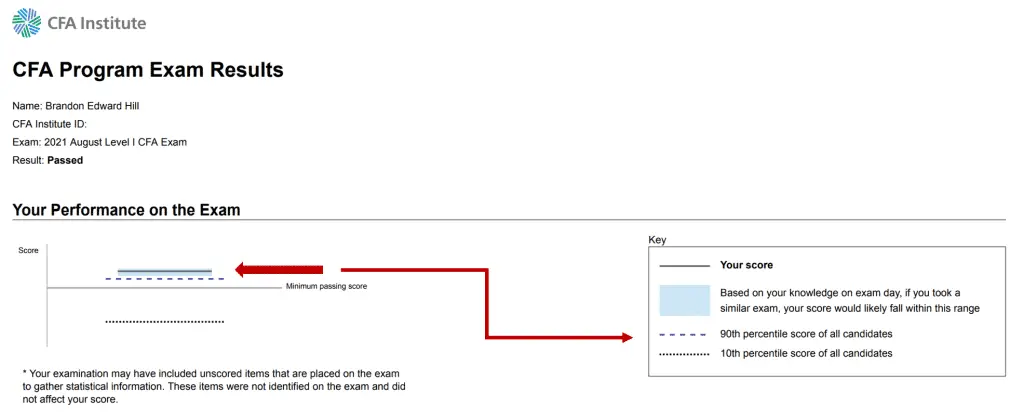
For my performance across the 10 topic areas, I ended up clearing the 70% mark on every single topic. I attribute these well-rounded results to the studying process I’m sharing with you today.
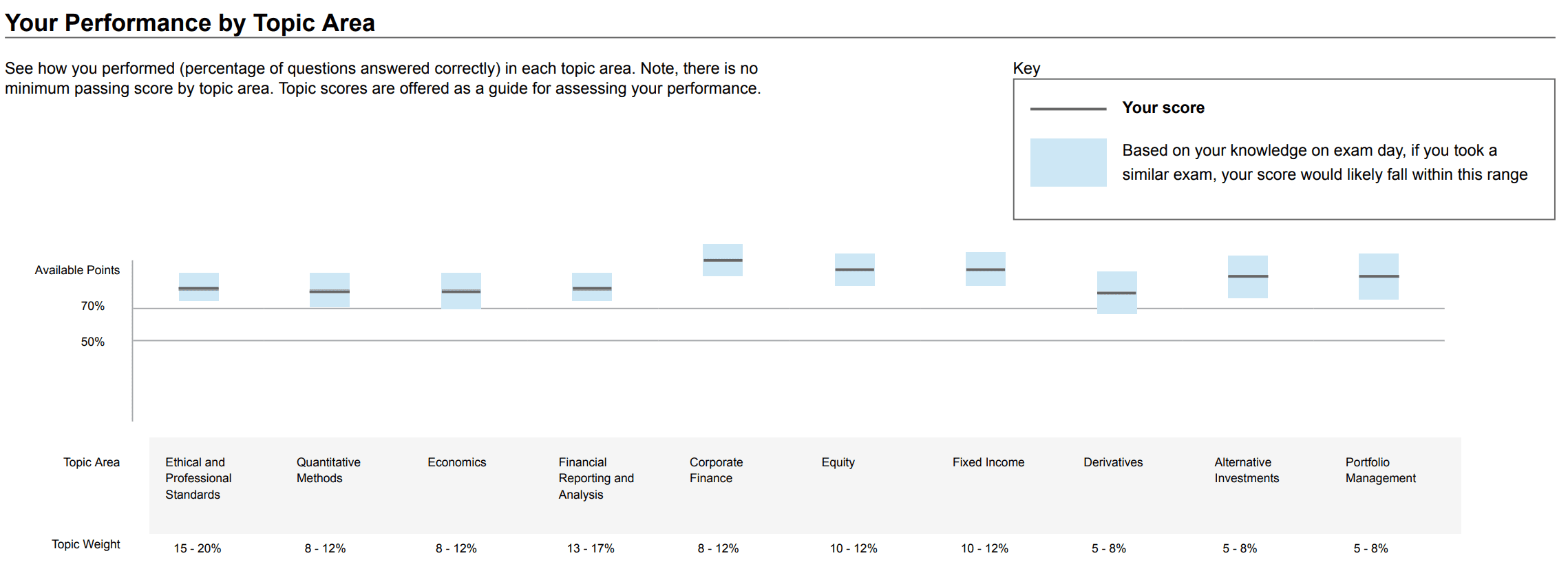
The Theme For Your CFA Level 1 Study Process
At the highest level, the theme for your study process boils down to two things:
- Efficiency
- Effectiveness
The average time spent studying for Level 1 is 300 hours. You want to be sure that you squeeze everything you can out of every single hour. There’s no point in aiming for 300 hours if you put in 300 lazy hours.
The way I think about studying is to make every hour as efficient and effective as I can. You want everything to be as streamlined as possible and you want to waste minimal time and energy.
The 6 Key Components to CFA Level 1 Study Preparation
How do I start preparing for CFA Level 1?
You should think of CFA Level 1 preparation in a holistic way. It isn’t just about the methods you use to practice and memorize material.
When embarking on your studying journey, there are many levers you can pull on to increase your chances of success. I call these levels the “key components.” The best methods on how to study for the CFA Level 1 exam have these six key components optimized.
The key components to Level 1 prep include:
- High-Level Timing of Your Study Plan
- Tools & Resources You Utilize
- Note-Taking & Learning
- Studying & Memorization Methods
- Organization & Scheduling of Individual Study Sessions
- Willpower & Energy Management
None of these components individually will guarantee that you pass, but collectively, if you can optimize each of these components, your odds of passing can skyrocket.
To teach you the best way to study for CFA Level 1, let’s dive into each component and talk about what actions you can take.
1. High-Level Timing of Your Study Plan
Timing is huge for Level 1. You can’t go through the material too fast or you might not grasp each reading as much as you need to. You also can’t go too slow or you won’t be able to learn everything and review in time.
When to start studying for the CFA Level 1 Exam?
I, and most people, recommend that you should start studying for the CFA Level 1 exam four to six months out from your exam day. I personally started six months out and thought it was the perfect amount of time.
For the first month or two, I was testing out different studying methods and routines. Once I actually found my groove, I was already down to only four to 4.5 months left until the exam.
How many hours to study for the CFA Level 1 Exam?
The reported averages for successful candidates show that they spend around 300 total hours studying for Level 1. I would agree with this, but with an important caveat: they need to be 300 productive hours.
Don’t just put in the hours to count them and reach the 300 mark. Study diligently and practice deliberately so each hour you spend studying is maximized.
I was an overachiever and really wanted to pass, so I ended up studying for around 400 hours. While 300 is the consensus recommendation, in the end, it’s all about your personal situation and how proficient you believe you are in the material.
How many hours per day should you study for the CFA Level 1 Exam?
If you start your study prep six months out from the exam and plan on studying 300 hours, you would have to study 1.66 hours per day, assuming that you study every single day of the six-month period.
Obviously, no one is going to be able to that.
The hours per day that you study for the CFA Level 1 Exam can—and should—vary over your six-month study journey.
I would recommend the following:
- First 1-2 months: one to two hours/day
- Next 2-3 months: two to three hours/day
- Final 4-6 weeks: Study as much as your schedule will allow (without burning out). Some days, you may study for two hours. Other days, you may study for eight hours. Shoot for about three to five hours per day.
If you abide by these benchmarks, you will be able to take days off and still hit the 300 hours mark.
2. Tools & Resources You Utilize
The second component to preparing for the CFA Level 1 exam is the tool and resources you utilize. You need something to learn the material from. You need a way to take notes and practice. And you need a tool to help you with your scheduling so you can stay on track.
CFA Institute (CFAI)
When you register for the CFA, you’ll automatically be given the textbook material provided by the CFAI and you’ll have an online platform that contains the textbooks, practice questions, mock exams, and mini-games.
Technically, this resource is all you would need to study for the exam, but many people (including myself) opt to sign up with a third-party test provider.
Third-party test prep provider: learning and practice
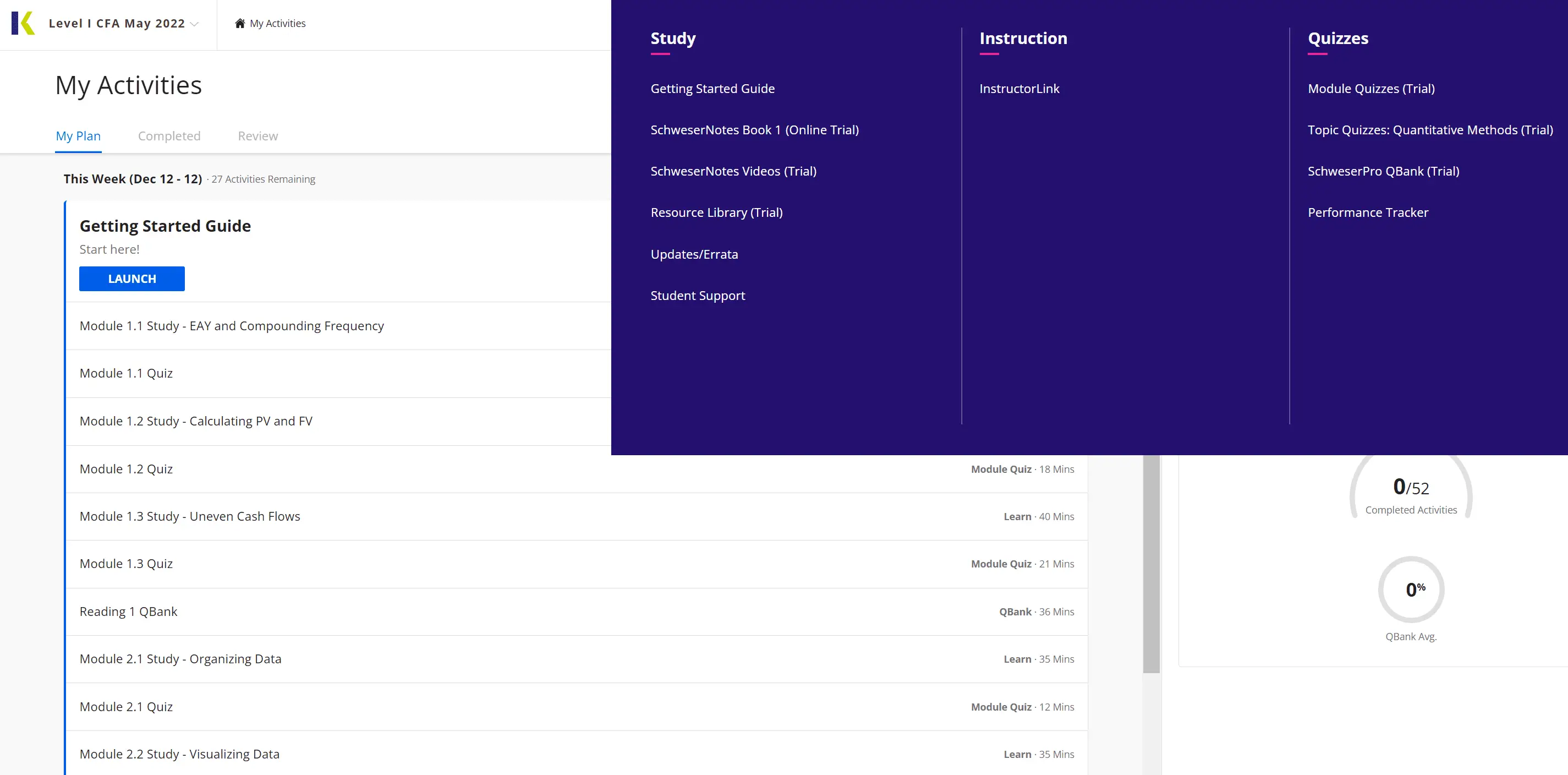
Third-party test prep providers will provide you with textbook materials, video lessons, thousands of practice questions, mock exams, and more.
The most popular test prep provider for CFA Level 1 include:
- Kaplan Schweser (this is the one I used)
- Wiley Efficient Learning
- Bloomberg Prep
- Mark Meldrum
- Analyst Prep
Candidates opt for these third-party providers because their textbook material and lessons tend to be more consumable than CFAI’s. CFAI will provide you with all the material you need, but it may actually be too much material.
Prep providers create concise textbooks and video lessons, so it’s easier to cover all the material.
Additionally, the online platforms of these providers can be more engaging and user-friendly. For me, I preferred Kaplan’s online platform over CFAI’s.
These third-party providers do cost money, but I believe they are worth their price. The last thing you want to do is spend hundreds of hours studying, only to fail and wish you had studied with Kaplan or Wiley’s material.
Notion: note-taking
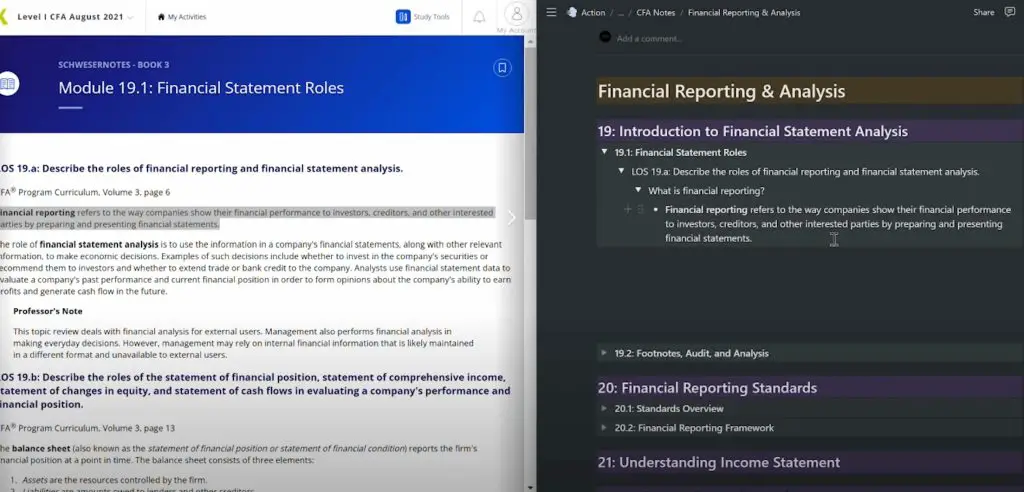
Before I talk about note-taking and flashcard creation, I’ll remind you that the theme of the CFA studying journey is efficiency and effectiveness.
I didn’t handwrite any of my notes when I was learning the Level 1 material. That may come as a surprise, but when efficiency and effectiveness are priorities, handwriting your notes is too time-consuming.
Instead, I used Notion to take notes. Notion is a program/app that can do a lot of things, but the main thing I used Notion for was to take notes that were comprehensive, organized, aesthetically pleasing, and accessible
I’ll go into more detail on this process in the 3rd component section.
Anki: flashcards
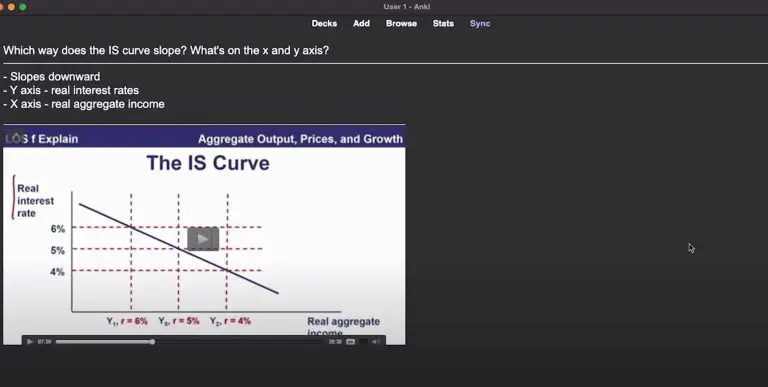
Flashcards are a common medium used for studying and memorizing Level 1 material. None of my flashcards were hand-written. All of them were created digitally with Anki.
Anki is a program that allows you to create comprehensive flashcards.
The benefit of creating flashcards digitally include:
- The speed at which you can create flashcards
- The customization you can do on your flashcards
- The ability to organize your flashcards into decks and sub-decks
- Accessibility from any computer, tablet, or mobile device
CFA Revision Spreadsheet: scheduling study sessions
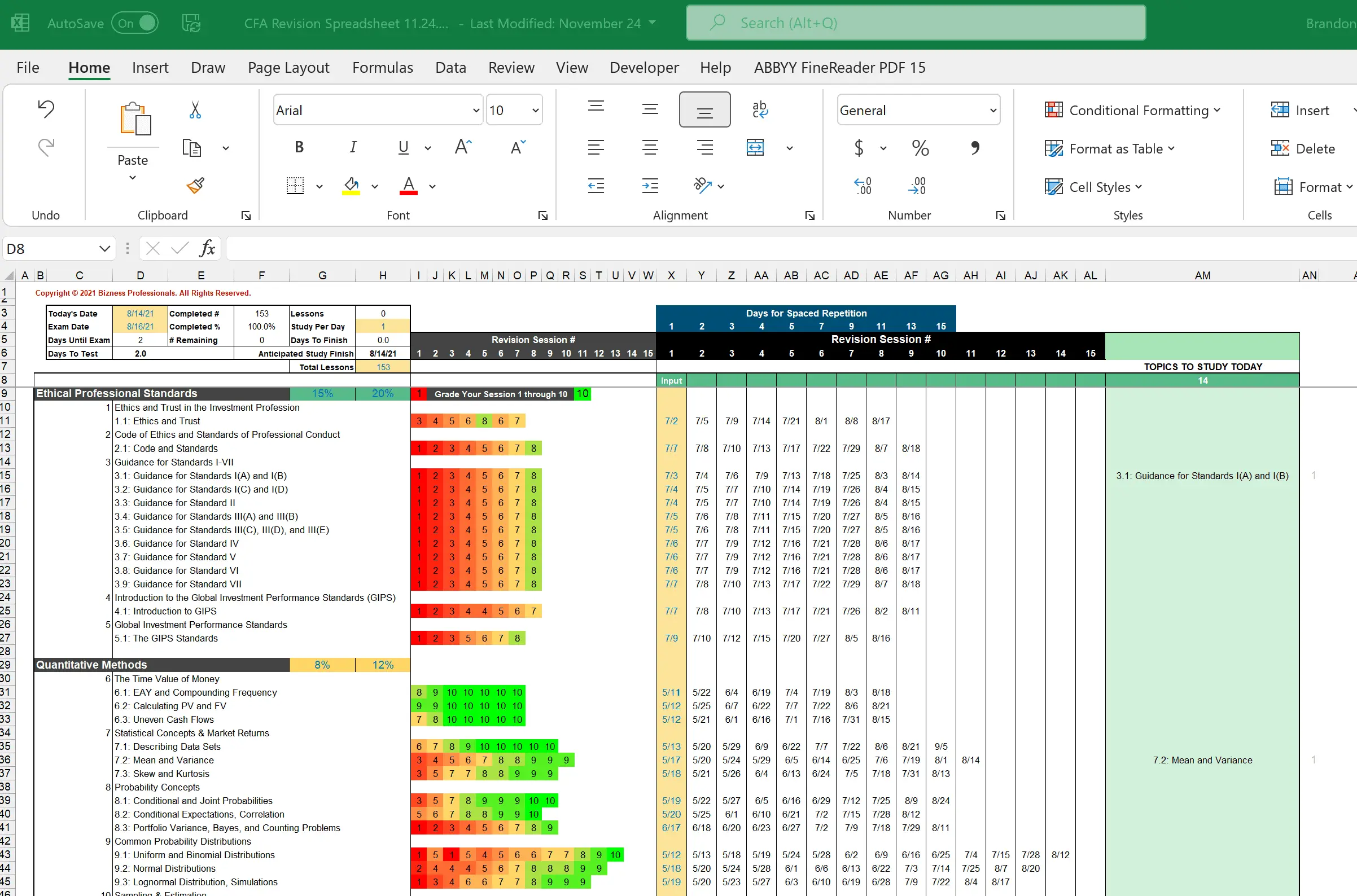
The CFA Revision Spreadsheet is an Excel spreadsheet that I created to optimally schedule each of my study sessions.
One of the hardest parts of studying for CFA Level 1 is balancing learning new material while trying to review past material you’ve learned so you don’t forget.
This spreadsheet contains formulas that work off spaced repetition. The sheet will automatically tell you when you should next study a lesson/reading. This ensures that lessons you struggle with are studied more frequently and lessons you are proficient in are studied less frequently.
We’ll dive deeply into the CFA Revision Spreadsheet in the 5th component section.
3. Note-Taking & Learning
Component 3 is note-taking & learning.
This component is all about your first time learning and taking notes on all the material that the test covers. In this stage, you are less worried about memorization and more focused on understanding.
How to Learn the CFA Level 1 Material
As you read the material, there may be things that you are already comfortable with and there may be topics that you have little knowledge on. As you study each lesson, you want to make sure you understand everything conceptually.
Really focus on the basics and fundamentals before you move onto more advanced material. Before you can memorize, you must first understand.
To facilitate your learning, you can take notes with Notion.
Notion is amazing because you can take notes digitally and keep everything functional, organized, and aesthetically pleasing.
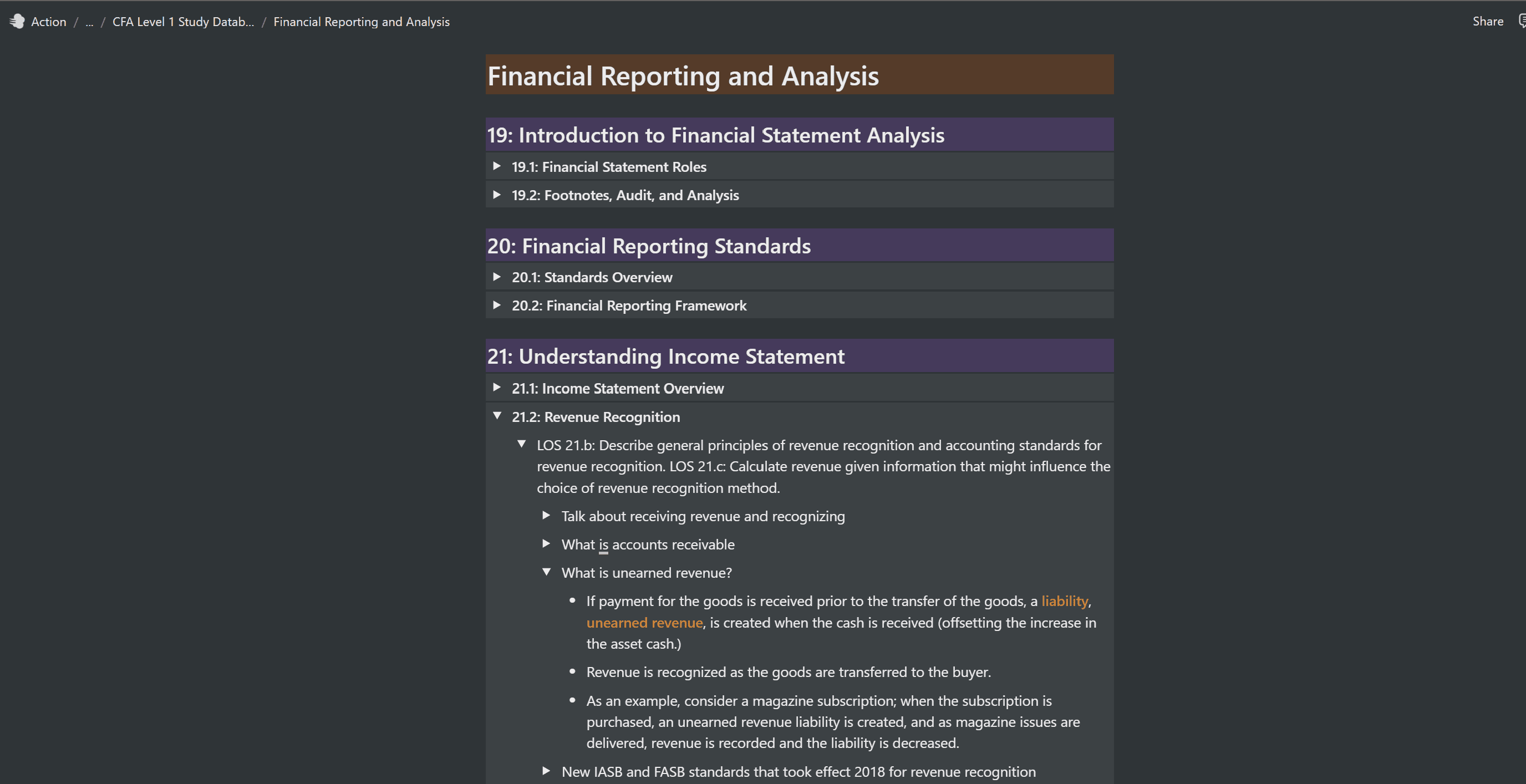
When I started taking notes, I used Kaplan’s online textbooks to learn from. I would split my laptop screen when I took notes. On the left, I had the online textbook open. On the right, I had Notion open.
As I would read the lecture, I would think of questions I could ask myself to test my understanding. This is called “active recall” and we will go into more detail on this in component 4.
Once I had a question in mind, I would create a toggle in Notion. Then, I would supply the answer to that question within the toggle. Now I could toggle the question on and off to show the answer.
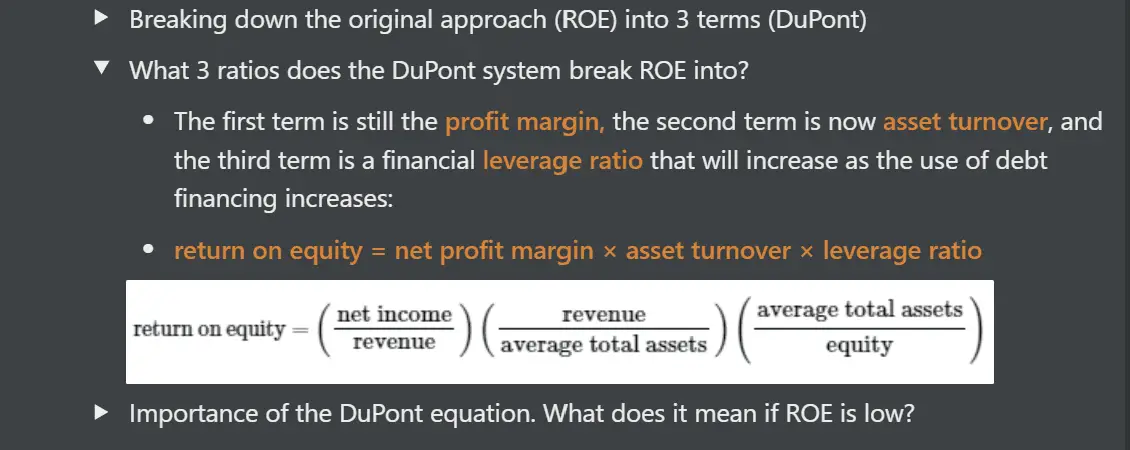
This is how I would take notes. I would read the textbooks and create active recall toggle questions. Everything would be clean and organized. And when I studied, I would read the toggle questions and attempt to answer the question before viewing the correct answer.
I found this style of learning/note-taking very effective.
4. Studying & Memorization Methods
After you learn and take notes, the next step is component 4: studying & memorizing. This component is the stage where you take what you’ve learned and try to perfect your understanding and cement the material in your long-term memory.
Your long-term memory is what you’ll need on exam day.
Before we talk about what you should do to study the CFA Level 1 material, let’s talk about the methods you should avoid.
Avoiding Ineffective CFA Study Methods
Some of the most popular study methods include:
- Highlighting textbooks and notes
- Rereading textbooks and notes over and over (rote memorization)
These are actually among the worst studying methods, which is stated frequently in the book Make It Stick, a popular book on the science of learning (see a review/summary here)
These methods are a form of passive learning, which doesn’t involve any reflection, engagement, or synthesizing of information. Because of this, we never fully grasp material. That leads to us having to reread or rewatch things over and over with hopes of the information eventually sticking.
You’ll want to avoid these ineffective methods and opt for active learning methods.
Active learning is a method of learning where an individual cognitively engages and interacts with the material they are trying to absorb. The methods I’ll suggest you use for your studies are all active forms of learning.
How to Study the CFA Level 1 Material
The core of your studying will utilize two active learning methods:
- Active recall
- Spaced repetition
Active Recall
Active recall is study method that involves quizzing yourself with a question and supplying an answer before you check what the actual answer is.
A great example of this is the use of flashcards.
With flashcards, you have a question on one side. You read that question and attempt to answer it before looking at the answer on the back of the card.
This is why we utilize Anki. It allows us to quickly create useful flashcards that test us with active recall.
One of the reasons active learning is such a great study technique is because it requires effort from your brain. In Make It Stick, the authors say that learning is more durable when it’s more effortful. You want your studying to work your brain.
Every time you work to retrieve an answer from your memory, the connections in your brain strengthen, thus strengthening your memory.
Examples of forms of active recall for the CFA Level 1 studying:
- Reading through material, stopping, and quizzing yourself on what you just read
- Flashcards
- Toggle notes with Notion
- Solving practice problems before looking at the answer
- Mini-quizzes
- Mock exams
Spaced Repetition
Spaced repetition is a studying technique that involves repeatedly reviewing information that you want to memorize at gradually increasing time intervals.
The objective is to review material just as you start forgetting it. You practice spaced repetition by studying the same material multiple times, while progressively increasing the time between each session.
Example:
If you have 15 financial formulas to memorize for a final exam, you would learn all 15 formulas for the first time several weeks before the test.
After the first time you learned the material, study again the next day. Then study the formulas 4 days later. Then again 7 days later. And so forth until the information is permanently stored in your long-term memory.
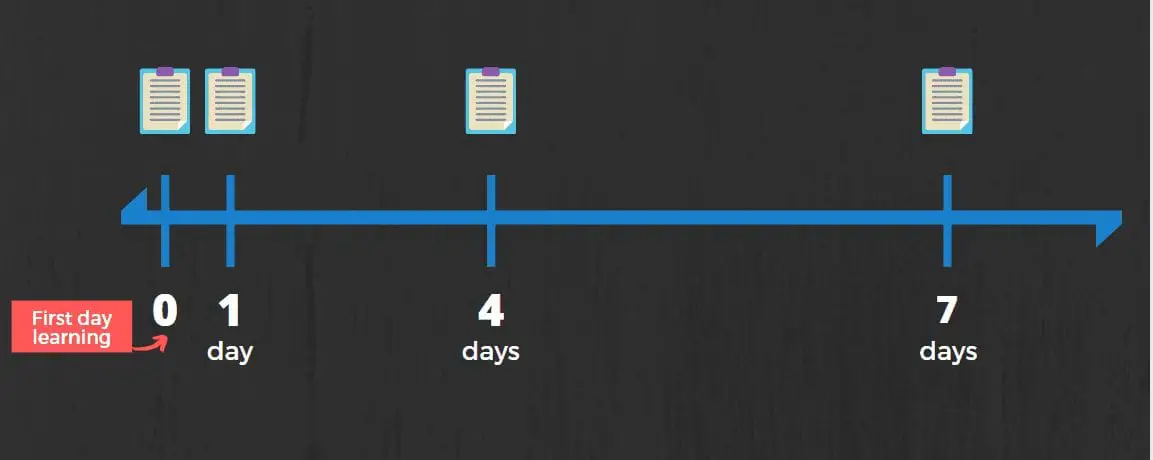
Now you can see why the method is called spaced repetition. You repeat the same study session over several intervals.
With this study system that I am recommending, you’ll implement spaced repetition by using the CFA Revision Spreadsheet. Let’s talk about that.
5. Organization & Scheduling of Individual Study Sessions
Component 5 is the organization and scheduling of individual study sessions.
The amount of material you have to consume and know for Level 1 is vast, and if you don’t have a schedule or study plan, you’ll quickly fall behind.
For the scheduling of study sessions, I would recommend using the CFA Revision Spreadsheet, which I mentioned is a Excel spreadsheet that I created to optimally schedule the study sessions for each lesson/reading of the CFA material.
As mentioned earlier, I used Kaplan as my third-party test prep provider for my 2021 CFA Level 1 Exam. For 2021, there were 57 readings (in 2022 there are 60). Within those 57 readings, Kaplan split each reading into sub-readings, or “lessons” that I refer to. There were a total of 153 lessons within the 57 readings.
With that background information shared, I’ll share that the CFA Revision Spreadsheet listed out all 153 lessons.
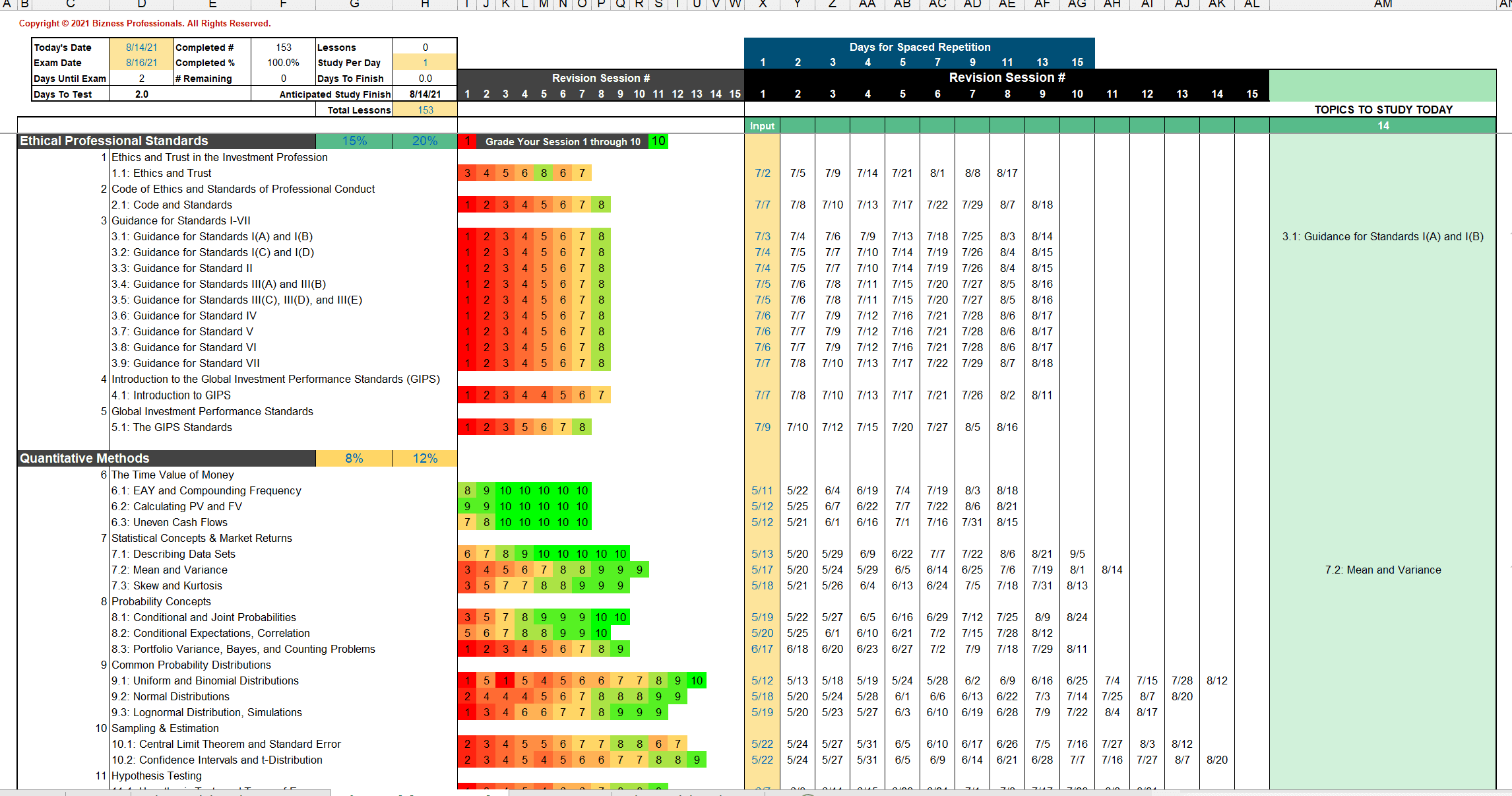
For every lesson, you’d rate your study session from 1-10, with 10 meaning that you have mastered that lesson. With these ratings, the formulas work based on spaced repetition. If you rated your study session a 2 for example, you would end up reviewing that lesson again 2 days later.
If you rated a session an 8, you would review that lesson 11 days later. (see below)
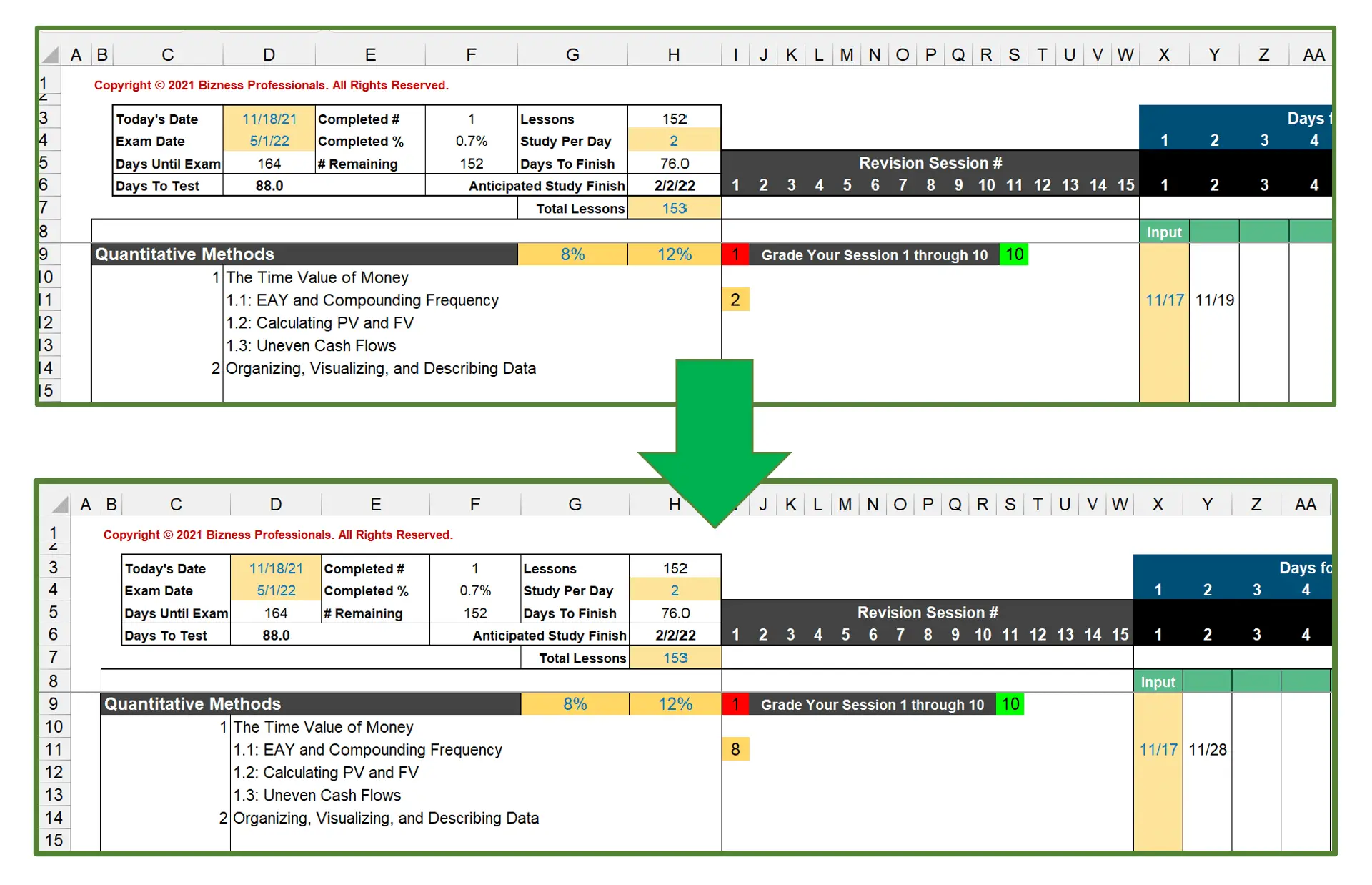
As the days go by, the spreadsheet will automatically tell you which lessons you have to review on that day.
This takes all the worrying out of your scheduling and allows you to just focus on studying and practicing. You’ll never worry about studying a lesson too frequently or too infrequently. It’s always optimized based on the 1-10 rating you give yourself.
This spreadsheet was the KEY to my personal Level 1 success.
As of May 2022, over 360 Level 1 candidates have purchased this spreadsheet to help them with their studies
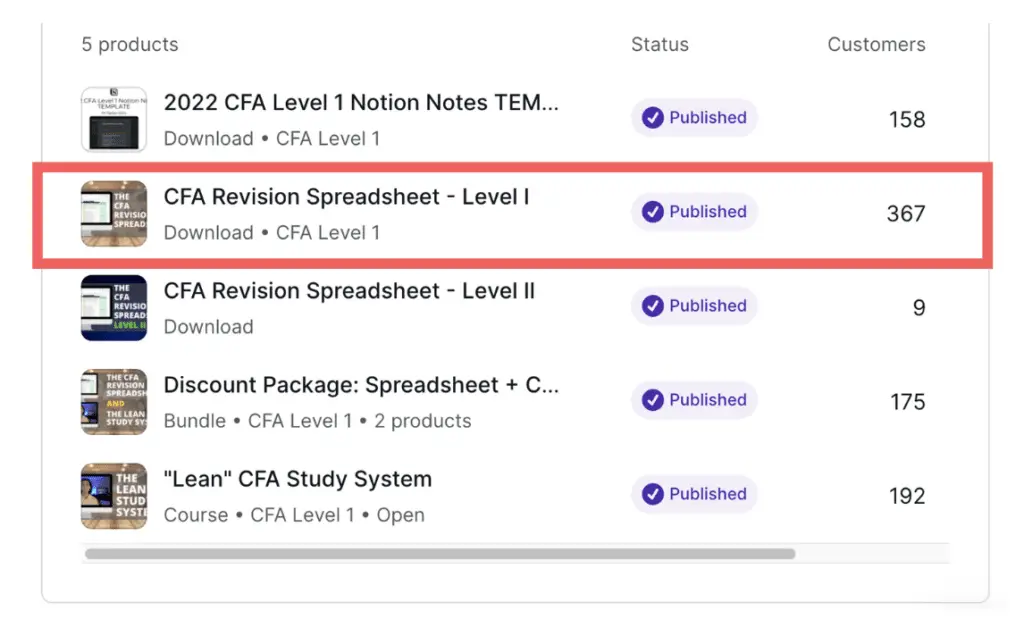
6. Willpower & Energy Management
Lastly, the 6th component is one of the most important, but probably the most overlooked: willpower and energy management.
From beginning to end, the CFA Level 1 journey is a marathon that requires pacing. You have to be able to bring your A-game every time you study and you need to maintain that for the four to six months that you study.
You can’t afford to have your mind and body operating at anything less than 100%.
To optimize willpower and energy management, work on improving…
- Sleep
- Diet & Nutrition
- Fitness
- Mental Health
Here are some resources that can help you out with all this. Treat your mind and body as a machine, like an athlete would. Do what you can to make sure the machine runs as smoothly as possible.
Summary
Studying for the CFA Level 1 test is a process with a lot of moving parts. It’s essential that you look at your studying in a holistic way. By doing so, you’ll increase your chances of success.
Resources
How can I learn more about how to implement this study system?
If you liked this post and want to learn more about how to implement this study system, I have an affordable course offered on my Podia account. This course will walk you through everything step by step.
It’ll go in-depth on how to use the tools we mentioned such as Notion, Anki, and the CFA Revision Spreadsheet. You’ll learn how to use them individually and how to use them all together in the greater study system.
How can I access the CFA Revision Spreadsheet?
If you want to access the CFA Revision Spreadsheet, you can also access that through my Podia Account. There is an option where you can just sign up to download the spreadsheet, without having to purchase the course.
About Post Author
Brandon Hill
I’m Brandon Hill with Bizness Professionals. We serve content to help young professionals develop personally, professionally, and financially. Well-rounded improvement is a theme we live by. As such, this website will cover a variety of topics aimed to help you have a successful life and career.
Brandon Hill
I'm Brandon Hill with Bizness Professionals. We serve content to help young professionals develop personally, professionally, and financially. Well-rounded improvement is a theme we live by. As such, this website will cover a variety of topics aimed to help you have a successful life and career.

